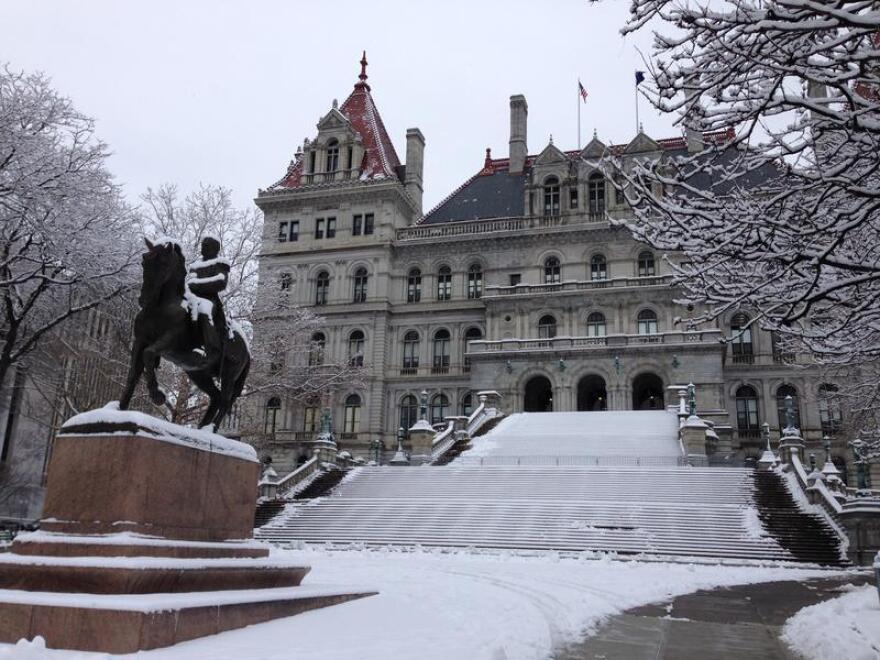Gov. Andrew Cuomo releases his state budget plan Tuesday afternoon, and he’s expected to detail how he will close a $6 billion budget gap. With resistance in the State Legislature to new taxes and spending cuts, the governor may have to get creative to thread that needle.
The budget gap is largely due to overspending on Medicaid beyond Cuomo’s self-imposed 2% per year spending cap. Factors include increases in the minimum wage, resulting in higher labor costs, and a spike in New Yorkers using Medicaid to pay for their health costs, as part of the Affordable Care Act.
Cuomo, speaking to reporters after an event in Orange County on Jan. 13, said he’ll lay out a plan in his budget, and there’s no need for concern.
“No one should worry,” Cuomo said. “Be optimistic, it’s going to work out.”
The problem has been brewing for some time. Each year since 2014, Cuomo’s budget office has shifted a bit of money at the end of one fiscal year into the next to stay within the spending cap -- on paper, anyway.
Each year, that amount grew, and in 2019, budget officials shifted an entire $1.7 billion reimbursement payment to providers like hospitals and nursing homes into the next fiscal year. They expect to do so again at the end of this fiscal year, which concludes March 31.
State Comptroller Tom DiNapoli, in an interview with public radio, said deferring payments is not a good long-term strategy, and it puts off an “inevitable reckoning” of how to control the cost overruns.
“Everyone was aware that there were deferrals going on,” said DiNapoli. “It’s never smart to kick the can down the road.”
In another attempt to constrain costs, Cuomo’s budget office on New Year’s Eve announced a 1% across-the-board cut to providers. But the $126 million it would save doesn’t come close to closing the multi-billion-dollar gap.
In his State of the State speech on Jan. 8, Cuomo hinted that counties, which also partially fund the Medicaid program, might have to pay more to help close the gap. Six years ago, the state froze the counties’ costs so that they did not have to pay for any increases in Medicaid spending. Cuomo complained that the state is now paying billions each year on “behalf” of the counties, as well as of New York City. And he said they are not being cost-conscious in administering the programs.
“It is too easy to write a check when you don’t sign it,” Cuomo said.
Counties, which in the past have asked the state to take over their entire Medicaid programs, issued a carefully worded statement. In it, the New York State Association of Counties praised the governor for initiating the cost cap, and said they want to be part of the discussions to trim the Medicaid budget.
One way to close a budget deficit is to raise taxes. Assembly Speaker Carl Heastie has already said his Democratic majority wants to look at ways to increase revenues, and has not ruled out more taxes on the wealthy.
Senate Leader Andrea Stewart-Cousins has said raising taxes is not her first choice. And Cuomo said he does not want to raise income taxes on the wealthy.
Heastie, speaking after Cuomo’s speech, said recent spending on Medicaid has resulted in a dramatic decrease in uninsured New Yorkers, with just 5% of state residents without health insurance. He said he does not want to see that progress jeopardized.
“We have 95% of the people in the state receiving health care. We don’t want to see that number go down,” Heastie said. “It’s going to be a long and complicated conversation.”
There are also signs that current tax collections might help close some of the gap. The comptroller’s report on third-quarter revenue collections found that personal income tax receipts are $1 billion over the amount initially projected, and business taxes are over $300 million more than anticipated.
The governor is expected on Tuesday to also propose amounts for funding school aid and provide details of other programs, including the legalization of adult recreational use of marijuana. Legalizing cannabis is estimated to bring in $300 million in additional revenues.




